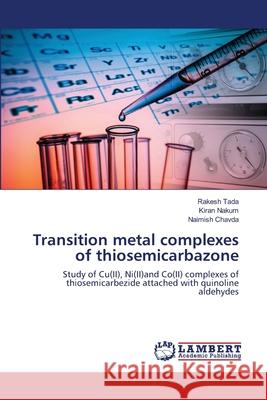Transition metal complexes of thiosemicarbazone » książka
Transition metal complexes of thiosemicarbazone
ISBN-13: 9783844322316 / Angielski / Miękka / 2014 / 68 str.
Summarizes the preparation and structure characterization of various thiosemicarbazones attached Quinoline aldehyde as well as their metal complexes. Synthesized ligands and metal complexes were characterized by different technique like mass, IR, 1H NMR, 13C NMR, UV-Visible spectroscopy as well as elemental analysis. In the elemental analysis of the synthesized compound both calculated and found percentages of elements are matched so elemental analysis confirms the structure of the thiosemicarbazone. Mass spectral data confirm the structure of the ligand as indicated by the molecular ion peak (M+) corresponding to their molecular weight. In IR spectra of the synthesized thiosemicarbazone showed useful information about the structure of the compound. In the IR spectra, some significant stretching bands due to -N-H, -N-N-, -NH2 and -C=S were observed at specific frequencies. In the 1H NMR spectra, the signal due to -CH=N-, -N-NH, NH2 and aromatic protons were observed in the expected regions. The 13C NMR spectrum provides direct information about the carbon skeleton of the synthesized compound.
Summarizes the preparation and structure characterization of various thiosemicarbazones attached Quinoline aldehyde as well as their metal complexes. Synthesized ligands and metal complexes were characterized by different technique like mass, IR, 1H NMR, 13C NMR, UV-Visible spectroscopy as well as elemental analysis. In the elemental analysis of the synthesized compound both calculated and found percentages of elements are matched so elemental analysis confirms the structure of the thiosemicarbazone. Mass spectral data confirm the structure of the ligand as indicated by the molecular ion peak (M+) corresponding to their molecular weight. In IR spectra of the synthesized thiosemicarbazone showed useful information about the structure of the compound. In the IR spectra, some significant stretching bands due to -N-H, -N-N-, -NH2 and -C=S were observed at specific frequencies. In the 1H NMR spectra, the signal due to -CH=N-, -N-NH, NH2 and aromatic protons were observed in the expected regions. The 13C NMR spectrum provides direct information about the carbon skeleton of the synthesized compound.











